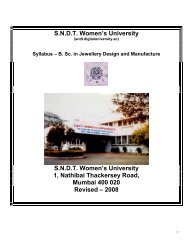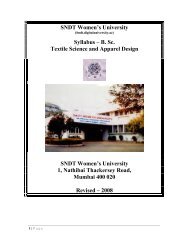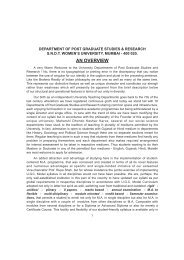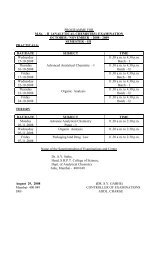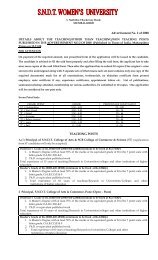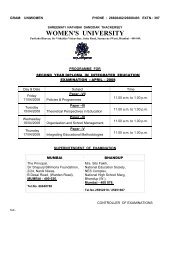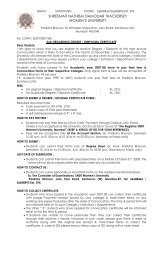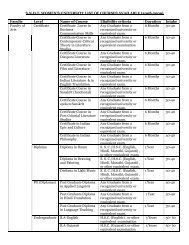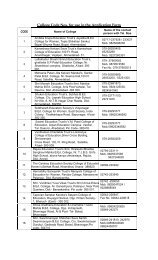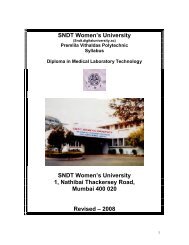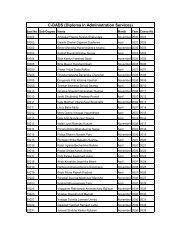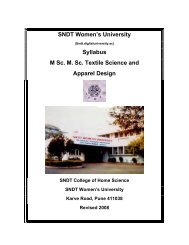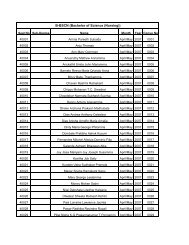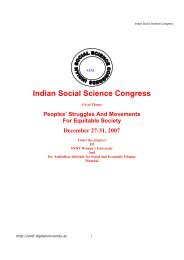SNDT Women's University SNDT Women's University 1, Nathibai
SNDT Women's University SNDT Women's University 1, Nathibai
SNDT Women's University SNDT Women's University 1, Nathibai
- No tags were found...
You also want an ePaper? Increase the reach of your titles
YUMPU automatically turns print PDFs into web optimized ePapers that Google loves.
<strong>SNDT</strong> Women’s <strong>University</strong>(Sndt.digitaluniversity.ac)Premlila Vithaldas PolytechnicSyllabus – Diploma in Electronics<strong>SNDT</strong> Women’s <strong>University</strong>1, <strong>Nathibai</strong> Thackersey Road,Mumbai 400 0201 | P a g e
Revised – 2008Eligibility: S.S.C or EquivalentObjectives:SYLLABUS FORMATFaculty ame: TechnologyCourse ame: Diploma in ElectronicsSCHEME: Semester IPaperSubjects L Cr P / D TP TW Pr TCodeTExamDE101 COMPUTER AND PROGRAMMING3 5 4 2 50 50 25 125CONCEPTSDE102 ENGINEERING PRACTICES: 1) WORKSHOP 0 3 4/2 0 0 50 25 75and 2) ENGINEERING DRAWINGDE103 MATHEMATICS - I 4 4 0 2 50 50 0 100DE104 LANGUAGE IN COMMUNICATION SKILL - I 3 3 0 2 50 25 0 75DE105 PHYSICS - I 3 5 4 2 50 50 25 125DE106 CHEMISTRY 3 4 2 2 50 25 25 100Total 60 24 14/2SCHEME: Semester IIPaperSubjects L Cr P / T D TP T P/ TCodeW VDE201 ELECTRICAL TECHNOLOGY 3 5 4 2 50 50 25 125DE202 ELECTRONIC MATERIALS AND3 5 4 2 50 50 25 125COMPONENTSDE203 MATHEMATICS – II 4 4 0/2 2 50 50 0 100DE204 LANGUAGE IN COMMUNICATION 3 3 0 2 50 25 0 75SKILL – IIDE205 PHYSICS –II 3 5 4 2 50 50 25 125Total 16 22 12/2SCHEME: Semester IIIPaperSubjects L Cr P / T D TP T P/ TCodeW VDE301 DOCUMENTATION TECHNIQUES – I 2 3 0/2 2 50 25 0 75DE302 CIRCUITS AND SYSTEMS 3 4 2 2 50 25 25 100DE303 DIGITAL CIRCUITS AND SYSTEMS 3 5 4 2 50 50 25 1252 | P a g e
DE304 BASIC ELECTRONICS AND CIRCUIT 4 6 4 2 50 50 50 150DESIGNDE305 MATHEMATICS - III 4 4 0 2 50 50 0 100Total 16 22 10/2SCHEME: Semester IVPaperSubjects L Cr P / T D TP T P/ TCodeW VDE401 ANALOG TECHNIQUES AND SPECIAL 3 5 4 2 50 50 25 125ICsDE402 ELECTRONIC INSTRUMENTS AND 3 4 2 2 50 25 25 100MEASUREMENT TECHNIQUESDE403 MATHEMATICS – IV 4 4 0/2 2 50 50 0 100DE404 INTRODUCTION TO4 6 4 2 50 50 50 150MICROPROCESSORSDE405 PRINCIPLES OF COMMUNICATION 3 4 2 2 50 25 25 100SYSTEMSTotal 17 23 12/2SCHEME: Semester V Internship (24 weeks)Log book = 50 , Industry Viva = 50, Implant Training Report = 50, Expert Viva = 50 . T = 200, Cr. = 8SCHEME: Semester VIPaperSubjects L Cr P / T D TP T P/ TCodeW VDE601 INTERFACING CIRCUITS 3 4 2 2 50 25 25 100DE602 POWER ELECTRONICS 3 5 4 2 50 25 50 125DE603 MICROCONTROLLERS AND4 5 2 2 50 25 50 125APPLICATIONSDE604 PRINCIPLES OF CONTROL3 4 2 2 50 25 25 100ENGINEERINGDE605 INSTRUMENTATION ENGINEERING 3 4 2 2 50 25 25 100Total 16 22 12SCHEME: Semester VIIPaperSubjects L Cr P / D TP TW P/V TCodeTDE701 DOCUMENTATION TECHNIQUES 2 3 0/2 2 50 25 0 75DE702 DATA COMMUNICATION AND3 4 2 2 50 25 25 100NETWORKINGDE703 INDUSTRIAL ORGANISATION AND3 3 0 2 50 25 0 75MANAGEMENTDE704 TELEMATICS 3 5 4 2 50 50 25 125DE705 ELECTRONIC PROJECT 0 8 0/16 0 0 100 100 200Total 11 23 6/183 | P a g e
SCHEME: Semester VIII Internship (24 weeks)Log book = 50 , Industry Viva = 50, Implant Training Report = 50, Expert Viva = 50 . T = 200, Cr. = 8L = o. of Lectures / week, P / T = Practical / Tutorial in hrs, D = Duration of Theory paper forExamination in hrs, TP = Theory Paper-marks, TW = Term Work - marks,P/V = Practical / Viva Voce - marks, T = Total, Cr = Credits4 | P a g e
Sr.No.Topic and DetailsDE103 - Mathematics-I(Scheme of Instruction: Theory-4Hrs/Wk; Credit-4)No. ofLecturesassigned1 Number system: Natural, rational, irrational, and real numbers 1 22 Progressions etc.: Arithmetic, and geometric progressions; Arithmetic 14 25mean, Infinite Geometric Series, Recurring Decimal numbers.3 Binomial Theorem: Binomial expansion, General and middle term in the 10 20binomial expansion, Binomial theorem for fractional and negativeindices, approximations4 Determinants: Concept; order of the determinant, Properties and10 20applications determinants5 Trigonometry: Concept; definitions and signs of trigonometric ratios, 15 20Fundamental identities, ratios of sum and difference of two angles,product formulae, ratios of multiple and sub-multiple std. angles,Inverse trigonometric functions.6 Trigonometric ratios of compound angles, product formulae, sum anddifference for multiple and sub-multiple angles inverse trigonometricfunction.10 13Weightagein %DE104 - Language in Communication Skill(Scheme of Instruction: Theory-3Hrs/Wk; Credits-3)Sr.No.Topic and Details1 Listening to and understanding English in the college environment:Discerning phonic differences, recognizing lexical markers, understandingtime and location references, taking notes during lectures imperatives,questions, subject-verb concord, infinitives and prepositions2 Reading and understanding basic scientific English: skimming for mainpoints, scanning for information, understanding use of voices (active &passive), noting details and examples, under-standing informationpresentations punctuation rules, inter-sentential connectives, voices, nounand adverbial clauses, typical subject-specific lexis.3 Writing English in socio-academic context: informal communication,writing descriptions of lab equipments and experiments; making requests,elaborating on given ideas, descriptive words, word particles, infinitives,conjunctives, word order, inter-sentential cohesion.4 Communicating orally for functional needs: practicing distinct sounds,comparing and contrasting effects of communication, narratingexperiences, giving responses at viva’s, giving oral explanations ofexperiments.No. ofLecturesassigned10 2010 2012 3013 30Weightagein %6 | P a g e
Sr.No.DE105 - Physics-I (Theory)(Scheme of Instruction: Theory-3Hrs/Wk; Practs-4Hrs/Wk; Credits-3+2=5)Topic and DetailsTHEORYNo. ofLecturesassigned1 Units: Introduction, physical quantities, systems of units, scalar and vector 2 52 Force: force as a vector, resultant force, laws of addition of forces,resolution of forces, moment of a force, laws of moments, resultant ofparallel forces, couple, velocity, periodic time, relation between linearvelocity and angular velocity, radial acceleration, centripetal andcentrifugal force, engineering applications etc.moment of couple (torque).6 103 Work, power and Energy, Definition of work, positive and negative work 4 10done, units of work, definition and units of power ,definition of energy,conservation laws, kinetic and potential energy.4 Circular motion: concept, tangential force angular displacement, angular 5 125 Machines: mechanical advantage, velocity ratio, efficiency, study of lever, 5 12wheel and axle, pulleys, inclined plane, simple screw-jack.6 Friction: Definition, limiting friction laws of friction, angle of friction, 4 10angle of repose, pulling on an inclined plane, Static kinetic and rollingfriction, application and disadvantage of friction7 Elasticity: introduction, types of deformation, elasticity, stress, strain, 4 10elastic limit and Hook’s law, Young’s modulus, elastic behavior of a wireetc., yield point, breaking stress.8 Static Electricity:: Concept of charge, Coulomb’s laws & unit of charge, 3 6electric field, electric Lines of force potential and potential difference,electromotive force the 'volt'.9 Capacitors: Definition and Unit, principal, different type capacitors in 4 10series and in parallel, energy stored in a capacitor.10 Current-Electricity: concept of current, resistance, Ohm’s law, Factorsaffecting the resistance Specific resistance, resistance in series and inparallel, 'Wheatstone’s Network', Meter Bridge, principal construction andworking, E 1 /E 2 using potentiometer (single cell method and sum anddifference method, Internal of cell using potentiometer8 15Weightagein %7 | P a g ePRACTICALSr.No.List of Experiments:No. of Hrs.1 To study the use of venire calipers. 42 To study the use of screw gauge. 43 To verify the Law of Moments. 44 To verify the Law of Parallelogram of forces. 65 To verify the Laws of Friction 46 To find M.A. V.R. and Efficiency of inclined plane. 47 To study the exponential decay of amplitude of simple pendulum. 68 To determine the unknown resistance using Ohm’s Law 49 To verify the Law of Series Combination of resistors. 410 To verify the Law of Parallel combination of resistors. 411 To determine the Specific resistance of the material of the wire using Meter 4
Bridge.12 To compare the e.m.f.’s of two cells using Potentiometer. 613 To determine the internal resistance of the cell using potentiometer. 6Sr.No.DE106 - Chemistry(Scheme of Instruction: Theory-3Hrs/Wk; Practs-2Hrs/Wk; Credits: 3+1=4)Topic and DetailsTHEORY1 Chemical Shorthand: Ionic valencies and their use in molecular formulae,the empirical formula, percentage compositions and related numericalproblems.2 Atomic Structure: Definition of an atom and a molecule, Dalton's theory,modern concept, isotopes, isobars, electronic configuration andconfiguration diagrams.3 The Periodic Table: Periodic law, modern long form of periodic table,elemental classification and periodic properties.No. ofLecturesassigned5 105 105 104 Atomic, molecular and equivalent weights; related numerical problems 5 105 Chemical substances: acids, bases, their properties, equivalent weights, 8 20Normality, Molarity, and Related numerical problems.6 Electrochemistry: Electrolysis, mechanisms, Faraday's Laws, and related 4 10numerical problems7 Water: Impurities, effects on industrial processes, purification, types,Estimation of hardness and Removal of hardness of water, the 'pH-scale':concept and its application chemistry, related numerical problems.8 20Weightagein %8 Chemical corrosion: Definition and theories of corrosion, Atmospheric andImmersed corrosion, types and prevention of corrosion5 10Sr.No.12List of Experiments:PRACTICALInorganic Qualitative Analysis: Spotting of captions like Na + , K + , Cu ++ ,Zn ++ , Mg ++ , NH + 4 ,Pb ++ , Fe +++ , and Al +++ ; anions like Cl¯, NO 3¯, SO 4¯ ¯,andCO 3¯ ¯.Volumetric Analysis: (1) Acidimetry-Alkalimetry, (2) Redox Titration, (3)Precipitation Titration.No. of Hrs.3 Determination of hardness of water by 'Soap Solution Method' 42068 | P a g e
9 | P a g e
DE201 - Electrical Technology(Scheme of Instruction: Theory-3Hrs/Wk; practs-4Hrs/Wk; credits-3+2=5)THEORYSr.No.Topic and Details1 Units and Basic Concepts : Units, Circuit elements and parameters,Fundamental laws and theorems, Kickoff’s laws, Thevenin’s andNorton’s theorems, Maximum power transfer theorem, Star DeltatransformationDC mesh and nodal analysis2 Circuit Transients and A.C. Fundamentals : RC, RL and RLC circuits,Response to sinusoidal and pulse inputs, Phasor representation, Power inAC circuits, Power factor and its improvement, Three phase circuits, Powermeasurement methods3 Transformers: Construction and working principles, Emf equation, Phasordiagrams, Equivalent circuits of single phase transformer, Efficiency andvoltage regulation, Open circuit and short circuit tests, Three phasetransformers.4 DC Motors: Construction and working principles, Back emf and voltageequation, Torque production, Series, shunt and compound motors andtheir basic characteristics, Starting, Speed control.5 AC Motors: Construction, Single phase induction motors, Torqueproduction, Methods of starting, Split Phase, Shaded pole, Capacitorstart and run motors, Operation and control of three phase induction andsynchronous motors.6 Selection of Motors: Choice of appropriate motors for specific engineeringapplications7 Power Generation, Transmission and Distribution: Various modes ofpower generation, transmission and distribution, Basic concepts, Standardsof generation and transmission voltages, Advantage of high voltagetransmission8 Non Conventional Sources and Energy Storage: Non conventional sourcesof electrical energy generation. Basic concepts, Solar and wind,Rechargeable batteries for energy storageNo. ofLecturesassigned8 188 188 185 104 84 104 104 8Weightagein %10 | P a g e
Sr.No.Topic and DetailsDE202 - Electronic Materials and Components(Scheme of Instruction: Theory-3Hrs/Wk; practs-4Hrs/Wk; credits-3+2=5)1 Materials and their properties1-a Conductor materials Pure metal & alloys conductivity and mechanicalstrength, super conductivity materials1-b Resistance materials: pure metals and alloys carbon and ceramic specificresistance temperature coefficient of resistance1-c Rectifying materials: metallic pairs, rectifying ratio and peak inversevoltage.No. ofLecturesassigned4 104 104 101-d Thermocouple material: thermoelectric effect, thermoelectric series. 4 101-e Photoelectric, photo-emissive and photo-conductive phenomenon anddevices, photo voltaic cell, piezoelectric materials, florescent andphosphorous materials4 101-f Magnetic materials: Electromagnetic domain theory, Ferromagnetic metalsand alloys, soft and hard magnetic materials, rectangular magneticcharacteristic materials, ferox cube, permittivity, hysterisis loop effect ofair gap on hysterisis loop, B-H curve, saturation, resonance and corrosiveforce, ac magnetic striction characteristics, ac power loss in electrical gradesheet steal,1-g Insulating materials: Cellulose, plastic glass, ceramic, liquids, compounds,siliconics, inert gasses, permittivity, DI-electric strength and power factor,FeO 2 ferrite, dielectric amplifiers2 Components: Resistors, capacitors, inductors, choke transformers,permanent magnets, electromagnets, switches, connectors, relay, zener,SCR, ICs, vacuum tubes gas tubes, transistors, dry cell, strong batteries(accumulators), photo transistors, LED, LCD, thermocouples, RTD Forabove components specifications, BSS, ICI, JSS, AGA, DEF.4 104 1012 20Weightagein %3 Fabrication technology and testing: Fabrication technologies for PCBs,single sided, double sided, multi-layer and flexible, etc. PTH technologiesscreen printing and photographic methods,5 10Practical:Study of standards and checking the component main characteristic by testing according to standardspecifications.11 | P a g e
DE203 - Mathematics-II(Scheme of Instruction: Theory-4Hrs/Wk; Tutorial-2 Credits-4+0=4)Sr.No.Topic and Details1 2D-Coordinate Geometry: distance formula, section formula Straight lineequationsin various forms, angle between two straight lines, parallel andperpendicular lines.2 Circle: Equation of a circle with given center and radius; general equationof a circle, equations of chord and tangent, normal to a circle.3 Functions: Definition and idea of a function; value of a function, differenttypes of functions, method of finding limits Limit and continuity.4 Differential calculus: Introduction to differentiation, Differentiation of sum,product, quotient, and that of exponential, logarithmic, trigonometric andinverse trigonometric functions; Differentiation of a function of a function,logarithmic differentiation, differentiation of parametric functions,differentiation of implicit function successive differentiation5 Applications of differentiation: geometrical meaning of derivative, maximaand minima of a function and its applicationsNo. ofLecturesassigned8 154 58 2030 4510 15Weightagein %12 | P a g e
DE204 - Language in Communication Skill-II(Scheme of Instruction: Theory-3Hrs/Wk; Credits-3+0=3)Sr.No.Topic and Details1 Negotiating meaning in verbal transaction within the academic context:judging stresses in Pronunciation, comprehending importance ofintonation, listening for essential message, stress signals, intonationconventions in speech, note taking conventions.2 Reading and analyzing scientific writing: Gleaning and collatinginformation, analyzing meaning of compound words, understandingimportance of qualifiers and modifiers, reading for global comprehension.3 Writing in academic generes: understanding meaning changes due tocollocation, using discourse markers, drawing essence of textual matter,preparing flowcharts of processes, describing a product, explainingconcepts deductively and inductively, defining briefly and in detail,collocation correctness, sentence synthesis, use of participles, paragraphcohesion, rhetorical devices.4 Communicating orally in the academic setting: formality enactingacademic roles in various contexts, interjecting, suggesting, seekingclarification, explaining experiments, giving vote of thanks, introducingspeakers5 Communicating orally in the professional context with colleagues,superiors, clients: discussing a problem to seek solution, seekingclarification, giving instructions, identifying audience needs andconcerns, describing a process/product with visual aids, explaining uses ofequipment and software intensifiers, audience consciousness, sentenceintonation, conversation techniques.6 Reading technical texts and writing professional English: using nominalcompounds, choosing appropriate writing aids, examining texts forwordiness, writing enquiries, responding to enquiries noun phrases,modifiers, parallelism, appositives, formatting conventions andeffectiveness in business communication.7 Effective oracy in communicating with executives, engineers, financiers etcin electronic industry: using facts to justify opinion, verbalizingproblems and seeking advice, suggesting alternative methods ofhandling tasks, responding to business related oral communication (face toface and telephonically), reporting difficulties on the shopfloor, describinguses of programmes or device, practicing sales presentations, practicinginterview responses.8 Communicating effectively in the electronic field for business and officialmatters: conveying information by memorandum, drafting brochure anduser manual, designing project report outline, drafting sales letters,drafting repair estimates, seeking bank loan, applying for employmentNo. ofLecturesassigned4 108 188 184 104 108 164 85 10Weightagein %13 | P a g e
DE205 - Physics-II(Scheme of Instruction: Theory-3Hrs/Wk; Practs-4Hrs/Wk; Credits-3+2=5)THEORYSr. Topic and DetailsNo.1 HEATING EFFECT OF ELECTRIC CURRENT: Statement andexplanation of Joule’s law, the expression for the amount of heat generatedin the conductor theoretically, construction of Joule’s calorimeter,determination of ‘J’ by electrical method, expression for electric power,relation between k. W. h. and joule, expression for energy consumed in k.W. h.2 THERMO-ELECTRICITY: Seebeck effect, thermo e. m. f., and thermoelectric current, construction and working of thermo-electric thermometer,Peltier effect, law of intermediate metals, law of intermediate temperature.3 ELECTROMAGNETIC INDUCTION: Definition of electromagneticinduction, Faraday’s laws of electromagnetic induction, Lenz’s law, selfinduction and definition of 1 Henry, mutual induction and hence definitionof 1 Henry4 SEMICONDUCTORS: Conduction band, Valance band, Distinguishbetween conductors, semiconductors and insulators on the basis of bandtheory, effect of temperature on the conductivity of semiconductors,negative temperature coefficient, different types of semiconductors, Needof adding an impurity in intrinsic semiconductors, examples of trivalentimpurity / acceptor impurity, formation of P-type semiconductors,examples of heptavalent impurity / donor impurity, formation of N-typesemiconductors. The formation of P-N junction, depletion region, barrierpotential.5 HEAT: Temperature scales, Boyle’s law, Gay Lussac’s law, Charle’s law,General gas equation using gas laws, absolute zero temperature, absolutescale / Kelvin scale of temperature, expression for work done in expandinga gas at constant pressure, specific heat of gas, specific heat of gas atconstant volume, specific heat of gas at constant pressure, Isothermal andadiabatic expansion of gas.6 HEAT TRANSFER: Different modes of heat transfer, transfer of heat byconduction, steady state of body, thermal conductivity, coefficient ofthermal conductivity, temperature gradient, Searle’s method to determinethermal conductivity of a good conductor, Lee’s method to determinethermal conductivity of bad conductor, applications of thermalconductivity, Newton’s law of cooling.7 SOUND: Wave motion, progressive wave, stationary wave, freeoscillations, resonance, vibrations of air column in a tube close at one end,velocity of sound using resonance tube8 ACOUSTICS AND ULTRASONICS: Reflection of sound, Echo,reverberation, conditions for good acoustics, the factors to be considered inacoustic planning of building, ultrasonic, production of ultrasonic waves,uses of ultrasonic waves9 OPTICS: Refraction of light, laws of refraction, refractive index ofmedium, refraction through prism, angle of minimum deviation, prismformula, Dispersion, dispersive power, expression for dispersive power,chromatic aberration, Interference of light, constructive interference,destructive interference, the conditions for steady interference pattern,diffraction of light, X- ray: Production if X-rays, Applications of X-rays.10 THEORY OF MAGNETISM: Different types of substances on the basis oftheir magnetic behavior, properties of diamagnetic substance, properties ofparamagnetic substance, properties of ferromagnetic substance, Magnetic14 | P a g eNo. of WeightageLectures in %4 104 104 106 126 125 104 104 105 103 6
hysterisis.PRACTICALSr.No.List of Experiments:No. of Hrs.1 To study the charging of capacitor. 62 To study the discharging of capacitor. 63 To verify K. V. L 64 To verify K. C. L. 65 To find ‘J’ by electric method 46 To map the magnetic lines of force 27 To find ‘G’ by shunting 48 To study the use of thermometer 49 To study the variation of angle of deviation with angle of incidence 610 To find the velocity of sound in air using resonance tube. 411 To verify Newton’s law of cooling 612 To find the specific heat of the solid by the method of the mixture. 615 | P a g e
SEMESTER-IIIDE301 - Documentation Techniques-I(Scheme of Instruction: Theory-2Hrs/Wk; Tutorial-2Hrs/Wk; Credits-2+1=3)Sr.No.Topic and Details1 Fundamental and derived units: Definitions, standard abbreviations,theirsymbols and use in the text. Numerical values for prefixes and suffixes toabbreviations of units. Sub- and super multiples of units.No. ofLecturesassigned4 15Weightagein %2 The Greek- alphabet, Arabic and roman numerals; facts and uses 2 63 Resistors/capacitors letters and digit (colour) codes. 4 154 Pro electron system of semiconductor device labeling. 4 155 Component Symbols. (BS 3939 and Drafting Manual -GEC): Discrete and 4 12integrated devices.6 Block diagram symbols 4 127 Frequency spectrum symbols. 2 78 Logic terms and definitions. 2 69 Standards: Concept and definition, their role and purpose. Example ofstandards and professional bodies: ISO, IEEE, IEC, NEMA, BS, DIN/JEE,the BISB (ISI) etc.4 12Laboratory activities:(1) Practicals based on Software tools - MS-Office ('MS-Word', 'MS-Power Point' and 'MS-Excel)'.(2). Visits to industry related to the above topics.16 | P a g e
DE302 - Circuits and Systems(Scheme of Instruction: Theory-3Hrs/Wk; Practs-2Hrs/Wk; Credits-3+1=4)THEORYSr.No.Topic and Details1 Network Elements and their Characterization: Resistance, capacitance andinductance parameters and their terminal properties. Voltage and currentsources – dependent and independent, Coupled coil.2 Foundations of Network Analysis: Topological descriptions of networks,KCL, KVL, Number of network equations, Source transformations,Examples of formulation of network equations, Loop and node variableanalysis and their solutions, Duality.3 Transient Response : RL and RC networks – free and forced responses ,initial conditions, RLC networks – free and forced responses, initialconditions, Transient response and s-plane roots, Continuity of current incoupled coils on switching.4 Transform Methods, Network Functions, Network Theorems: Conceptof complex frequency, Transform impedance and transformed circuits,Superposition and reciprocity, Thevenin’s and Norton’s theorems, Networkfunctions for one and two-ports, Calculation of network functions, Polesand zeros, Time domain behavior from pole zero plots5 Sinusoidal Steady State Analysis: Meaning of the term, Sinusoidal analysisusing exp (jwt) excitation, Phasors and phasor diagrams.6 Energy and Power: Energy and power in L, C and R elements, Effectiveand RMS values, Average and complex power, Maximum power transfertheorem and its applications, Tellegen’s theorem.7 Resonance: Amplitude and phase response, minimum phase functions,Single tuned circuits, double tuned circuits, Poles, zeros and time delay.8 Two-port Networks: Two-port parameters (z, y, h, ABCD) and theirinterrelationships, Transfer functions using two-port parameters,Interconnection of two-ports, Analysis of ladder networks.No. ofLecturesassigned4 108 164 108 164 108 164 105 12Weightagein %PRACTICALSr.No.List of Experiments:No. of Lectures assigned1 Network Theorems: .Millman’s, and 'Superposition Theorem' 122 Study of Resonance: Series resonance, and Parallel resonance 123 Wave shapers: RC differentiator. and RC integrator 124 Time constants of RC circuits 125 OC-, SC-test on transformer 1217 | P a g e
DE303 - Digital Circuits AD Systems(Scheme of Instruction: theory-3Hrs/Wk; Practs-4Hrs/Wk; Credits-3+2=5)THEORYSr.No.Topic and Details1 Logic families: DTL-, TTL-, ECL-, MOS- families and theircharacteristics; circuit details, analysis, and loading rules2 Number System: Decimal, Binary, Octal, and Hexadecimal systems; BinaryArithmetic, BCD and Gray code. Boolean Algebra and the 'DeMorgan’sTheorems'3 Logic Gates: BUFFER, NOT, AND, OR, NAND, NAND, NOR, X-OR,and X_NOR gates4 Combinational Logic Circuits: SOP and POS forms, reduction andinterconversion of forms, logic design using K maps.5 Adder & Subtractor circuits: Half adder, full adder, half subtractor, fullsubtractor; design of all these circuits. using discrete gates, study ofIC7483.6 Flip-Flops: RS flip-flop, J-K, D-, T-flip-flops; Racing problem and theMaster-Slave J-K flip-flop7 Sequential Logic Circuits: Design of asynchronous and synchronousup/down counters, Shift Registers: SIPO, SISO, PIPO, and PISO register8 Multiplexers, demultiplexers; decoders and encoders using TTL-ICs:74151, '138, '139, '47, '45, '42,'147 and CMOS-ICs: the 40XX series.9 Analog to digital and digital to analog converters: Basic terms anddefinitions, Conversion methods, Types of converters.No. ofLecturesassigned8 164 104 104 104 104 88 164 105 10Weightagein %PRACTICALSr.No.List of Experiments:No. of Lectures assigned1 Verification of truth tables of the gates using ICs 7400, '02, '32, '08, '86 etc 62 NAND and NOR gates as universal circuit building blocks 63 Design of Adders and Subtractors:HA, FA, HS, FS.etc. 64 Study of Flip-flops: JK flip flop (IC-7476) and D flip flop (IC7474). 65 Design asynchronous up/down counter using IC-7476. 66 Design of synchronous up/down counter using 7478. 67 Study of IC 7493 68 Study of shift registers 69 Study of MUX and DX 610 Study of 4Bit to Seven Segment Decoder-Driver IC-7447. 618 | P a g e
DE304 - Basic Electronics & Circuit Design(Scheme of Instruction: Theory-4Hrs/Wk; Practs-4Hrs/Wk; Credits-4+2=6)THEORYSr.No.Topic and Details1 Semiconductor Diodes: pn-junction diode: structure, operation,characteristics and parameters, characteristics of zener, photo, lightemitting, and varactor diode; applications of diodes.Bipolar JunctionTransistor: structure, operation and characteristics, h-parameters, CE-, CB-,and CC-configurations, BJT applications. Field Effect Transistor: Structure,operation, and characteristics, IGFET, MOSFET and equivalent circuits.VMOS, PMOS, and NMOS devices.Power supplies: Rectifiers, ripplefactor, efficiency of a rectifier etc. L-, C-, LC- and Pi-filters, ripple factorin each, need for voltage regulation.No. ofLecturesassigned20 35Weightagein %2 Regulated Power Supplies: Simple zener voltage regulator, transistorized 8 15series and shunt regulators; Design of regulated power supplies usingvoltage regulator IC`s like: 78XX and ,79XX series, ICs: LM723, LM 317,LM 337 etc.3 Introduction of 'SMPS' and UPS. 4 84 Design of voltage amplifiers: Load line analysis of transistor amplifier, 8 15hybrid parameter model, Design procedure.5 Design of RC- and Transformer coupled amplifier; Negative feedback 8 15amplifier design & applications, Power amplifiers.6 Design of RC and LC oscillators. Multivibrators, Sweep generators 12 12PRACTICALSr.No.1List of Experiments:Unregulated power supply using (a) H.W.R; (b) F.W.R. (C.T.);(c) F.W.R.(Bridge).No. of Hrs.122Regulated power supply using (a) Zener diode regulator; (b) Seriesregulator83 D.C amplifier and A.C amplifier 84 Two stage amplifier 85 R-C phase shift and Wien Bridge sinusoidal oscillators 86 LC sinusoidal oscillator: Hartley & Colpitts configurations 87 Relay driver 819 | P a g e
Sr.No.Topic and DetailsDE305 - Mathematics-III(Scheme of Instruction: Theory-4Hrs/wk; Credits-4+0=4)No. ofLecturesassigned1 Partial fractions:-Resolution of rational fraction into simple fractions 8 102 Integral Calculus: Rules of integration, standard results; integration of 20 30algebraic rational functions, standard integrals, integration bysubstitution, integration by parts, integration using partial fractions,standard integrals involving radicals3 Application of Integration: Area under a curve, volume of a solid Definiteintegral, properties of definite integrals, average values, root-mean-squarevalues etc.10 204 Differential equations : order and degree, formation of differential equation,solution of differential equations, variable separable homogeneousequations, linear equations, Bernollie’s equation.15 305 Applications of differential equations. 7 10Weightagein %20 | P a g e
Sr.No.Topic and DetailsSEMESTER-IVDE401 - Analog Techniques & Special IC’s(Scheme of Instruction: Theory-3Hr/Wk; Practs-4Hrs/Wk; Credits-3+2=5)THEORY1 Introduction to Operational Amplifier: Introduction to important terms anddefinitions, generalized differential amplifier and concept of commonmode rejection. The 'Emitter-Coupled Differential Amplifier', Op-amp as amulti-stage amplifier system , determination of Op-amp parameters;Interpretation data sheets and selection procedure while designing.2 Op-amps in Linear Analog Systems: The basic inverting amplifier; D.Cvoltage to current and current to voltage converter, DC current amplifier;Instrumentation and bridge amplifier; Stable AC coupled amplifier, A.Cvoltage follower, Analog differentiator and integrator; Analog computation.Active filters; Sinusoidal-oscillators (All: phase-shift, resonant circuit andWien Robinson Bridge type); Delay equalizers ( Magnitude and phase).3 Op-amps in Linear Analog Systems: The basic inverting amplifier; D.Cvoltage to current and current to voltage converter, DC current amplifier;Instrumentation and bridge amplifier; Stable AC coupled amplifier, A.Cvoltage follower, Analog differentiator and integrator; Analog computation.Active filters; Sinusoidal-oscillators (All: phase-shift, resonant circuit andWien Robinson Bridge type); Delay equalizers ( Magnitude and phase).4 The Integrated Circuit Timer IC-555: Basic structure, Principle ofoperation and waveforms, application as astable monostable and bistablemultivibrator, applications in industry, designing of circuits using IC-555.5 The Monolithic VCO-IC 566: Basic schematic structure, Principle ofoperation and waveforms, Extension to positive and negative ramp andpulse generation, frequency modulation and other applications, Remarkson usage.6 The Monolithic Function Generator-IC 8038 & XR 2206: Basic Schematicstructure, Principles of operation and wave-forms, practical circuit forfunction generation, Remarks on usage.No. ofLecturesassigned6 156 156 126 126 126 127 Static and Dynamic Displays. 3 88 Special ICs: LF398 CD 4046 & their applications 3 89 CAI amplifier, PLLs, active filters. 3 6Weightagein %PRACTICALSr.No.List of Experiments:No. of Hrs.1 Multivibrators (Astable, Schmitt) 82 Determination of V io & V oo , I, I io , A vo (jw) Vs frequency of a given Op-amp 83 Determination of CMRR and PSRR and slew rate 64 Inverting and Non-inverting amplifier circuits. 65 Study of Precision Half- and Full-wave Rectifier circuits. 66 Study of differentiator and integrator circuits. 67 Study of Monolithic IC 566 based Voltage controlled oscillator ckt. 68 Study of IC 8038 Waveform Generator Circuit. 69Study of IC 7217.821 | P a g e
DE402 - Electronic Instruments & Measurement Techniques(Scheme of Instruction: Theory-3Hrs/Wk; Practs-2Hrs/Wk; Credits-3+1=4)THEORYSr.No.Topic and Details1 Measurement Fundamentals: Definition of measurement andinstrumentation, classification of transducers, Static PerformanceCharacteristics: Accuracy, Precision, Linearity, Transmitters,Transponders, Hysterisis, Dead band. Errors in measurement: Gross errors,Systematic errors and Random errors, Calibration and Standards.2 Current & Voltage Measurements: Multimeter or VOM, Electrostaticrectifiers & thermocouple instruments, Electronic Multimeter, DigitalVoltmeters,3 Resistance and Impedance Bridges: Wheatstone bridge, Kelvin doublebridge, Capacitance comparison bridges: Schering Bridge for measurementof capacitors, Inductance comparison bridges: Maxell, Hay and Wienbridges, Q-Meter.No. ofLecturesassigned2 54 86 15Weightagein %4 Signal Generation: The Sine-wave generator, Frequency Synthesized 6 15Signal Generator, Frequency Divider generator, Sweep-frequencyGenerator, Pulse and Square-wave Generators, Function Generator, AudioFrequency Signal Generation.5 Oscilloscopes: Oscilloscope Block diagram, Cathode Ray tube, Vertical 6 15Deflection System, Delay line, Multiple trace, Horizontal DeflectionSystem, Oscilloscope Probes and Transducers, Special Oscilloscopes:Storage and Sampling Oscilloscopes. (Basics only)6 Frequency and Phase Measurement: Frequency and Phase measurements 6 12using CRO, Frequency counters, Period measurement, Extending theFrequency range of the Counter, Digital frequency & period counters.7 Magnetic Measurements: Quantities measured in Magnetism,2 4Measurement of Flux by Induced EMF.8 Radio frequency Power Measurement: Measurement of RF power: with a 6 12Thermocouple RF Ammeter, with an RF Voltmeter and by using a Toroidalcore Current Transformer, RF Power measurement using a Thermal Sensor,Thru line RF Wattmeter, Bolometer method of Power Measurement.9 Signal Analysis Instruments: Wave Analyzers, Harmonic Distortion 5 10Analyzers, Spectrum Analyzers.10 Principles of Q-meter, distortion-factor meter, wave analyzer. 2 4PRACTICALSr.No.List of Experiments:No. of Hrs.1 Study of bridges: DC and AC bridges. 82 Study of a CRO. 83 Study of Generators: Laboratory and RF signal generators. 84 Study of meters: Frequency and power meter. 622 | P a g e
DE403 - Mathematics IV(Scheme of Instruction: Theory-4Hrs/Wk; Tutorial-2Hrs/Wk Credits-4+0=4)THEORYSr.No.Topic and Details1 Fourier Series: Introduction, Euler’s formula, Fourier expansion offunctions having some points of discontinuity, change of interval; odd andeven functions, Fourier expansion of odd and even periodic functions;Half range Fourier series etc.2 Laplace Transforms: Definition, Laplace transforms of elementaryfunctions; Properties of Laplace transform, Inverse transforms; Transformsof derivatives. Applications of Laplace transforms to solution ofdifferential equations; unit step function and its Laplace transform.3 Vector Algebra: Definitions, addition of a vector, position vector, coordinationsof a point in a space, scalar product of a vector, application ofdot product, vector product4 Complex numbers: Definitions Argand diagram, modulus and amplitude ofa complex number, polar form, De-moivers theorem, roots of complexnumber.5 Matrices: definition, types, algebra, multiplication, transpose, adjoin andinverse of a matrix.6 Partial Differentiation: Partial derivatives, Euler’s theorem onhomogeneous functions, total derivative.No. ofLecturesassigned12126688Weightagein %DE404 - Introduction to MicroprocessorsSr.No.23 | P a g e(Scheme of Instruction: Theory-4Hrs/Wk; Practs-4Hrs/Wk; Credits-4+2=6)Topic and DetailsTHEORYNo. ofLecturesassigned1 Organization of microcomputer: block schematic, concept of bus; address-, 6 10data- and control-bus.2 The 8085 Architecture: Pin diagram, functional block diagram, register 6 10structure, I/O-signals, machine-cycle, timing diagram for fetch, read,write operation (with and without ready signal).3 Memory and Interface Signals: Different type of memories -RAM, ROM, 12 20PROM, EPROM, EEPROM, Memory mapping; demultiplexing OFaddress & data bus, address decoding of read-, write-, and I/O-M linesand ready lines.4 Instruction Set of the 8085: concept of instructions, opcode and operand, 12 20single, two and three byte instructions, addressing modes, classificationof instructions according to operation.5 Programming in Assembly Language: Instruction set, Logic operations, 6 10data manipulation, block transfer indexing instructions; Subroutines(nested), delay loop, stack utilities; I/O addressing.6 Interrupts: Concepts of interrupt, vectored interrupt scheme of 8085, use of 6 10Weightagein %
RIM and SIM instructions for altering priority order, Restart instructions.7 Concept of DMA. 6 108 Input/Output peripherals: Concept of memory mapped I/ O and I/O mappedI/O: Peripheral chips like 8155, 8255, 8755, and 8355.6 10PRACTICALSr.No.List of Experiments:No. of Hrs.1 Introduction to the 8085 kit. 82 Introduction to the mnemonics and machine codes of the 8085 processor. 83 Data transfer programs. 84 Arithmetic operations 85 Addition ( 8 bit, 16bit signed, unsigned). 86 Subtraction (8bit, 16bitsigned, unsigned). 67 Multiplication ( 8 bit, 16bitsigned,unsigned). 68 Division (8 bit, 16bit signed, unsigned). 8Sr.No.DE405 - Principles of Communication System(Scheme of Instruction: Theory-3Hrs/Wk; Practs-2Hrs/Wk; Credits-3+1=4)Topic and DetailsTHEORYNo. ofLecturesassignedWeightagein %1Electromagnetic Wave Propagation: Ground wave, sky wave, space waveand tropospheric propagation.6 152Modulation: Need for modulation, its types; AM , FM etc., theirrepresentation, comparative study, methods of generation, transmitter: 12 25block diagram and working, Pulse modulation: PAM, PPM, PCM, PWM.3Radio Receivers: TRF receivers and superhetrodyne receivers, blockdiagram and working of AM and FM receivers. Communication receivers - 8 18basic concept with block diagram.4Television Fundamentals: TV cameras, Transmission of T.V. Signalscanning process, VSB technique, video bandwidth requirement.8 185Antenna: Basic consideration, antenna gain, antenna resistance, bandwidthand polarization, types of antenna.8 186 Transmission lines – characteristics impedance, interactive impedance. 3 6PRACTICALSr.No.List of Experiments:No. of Hrs.1 Modulation Techniques: AM, FM, PAM, PPM, and PWM. 62 AM Detection and automatic Gain control. 63 Study of Radio Receivers and Single Side Band Receiver. 64 Study of Television Receiver on trainer kit. 45 Study of Pattern Generator. 46 Study of Delta Modulation. 424 | P a g e
SEMESTER-VITERSHIP PERIOD = 24 WEEKS (Credits: 8)SCHEME: Logbook=50 + Industry Viva=50 + Report=50 + Expert Viva=50 = 200 MarksDuring this semester, students receive first module of in-plant training in reputed electronic industries. Theobjective of this training is to acquaint them with basic assembling and testing of electronic products as well asto make suited to the working environment of the industry. Each student is looked after by any of thedepartment faculties by means of periodic visits.25 | P a g e
Sr.No.SEMESTER-VIDE601 - Interfacing Circuits(Scheme of Instruction: Theory-3Hrs/Wk; Practs-2Hrs/Wk; Credits-3+1=4)Topic and DetailsTHEORYNo. ofLecturesassignedWeightagein %1 Keyboard type of keyboards, Keyboard and Display controller-8279. 6 122 Programmable Interrupt controller-8259. 4 103 USART-8251. 6 124 Programmable-DMA Controller-8257. 6 155 Introduction to the 8253 (PIT) and its Application. 5 106 FDC-8272. 4 107 CRT Controller-8275. 5 108 ADC and DAC 0800, 0809/0816. 5 109 Serial and parallel Bus standards. 2 510 Introduction to 8086. 2 6PRACTICALSr.No.List of Experiments:No. of Hrs.1 Waveform generation. 42 Co-ordinate axis drawing. 43 8279 Rolling display, flashing display. 44 Kit as a function generator. 45 Monitor utilities. 46 Stepper motor control. 47 Study of Programmable Unity Gain Amplifier 626 | P a g e
Sr.No.DE602 - Power Electronics(Scheme of Instruction: Theory-3Hrs/Wk; Practs-4Hrs/Wk; Crdits-3+2=5)Topic and DetailsTHEORYNo. ofLecturesassignedWeightagein %1Study of Power Devices: UJT, SCR, TRIAC, DIAC, PUT, SUS, V-ICharacteristics, operations specifications, ratings.6 152Triggering of SCR: Methods of triggering, simple resistor and RC triggercircuits, semiconductor trigger pulse generator using UJT, PUT, SUS etc,neon glow lamps as trigger devices, use of pulse transformers,6 15synchronization methods, trigger circuit for inverters.3Dynamic characteristics of SCR, SCR turn ON, turn OFF time, SCR turnOFF methods: class A, class B, class C, class D, class E, class F etc.6 154 Series and parallel operation of SCR. 2 45AC Phase control circuits: Principle of phase control, using thyristor onincandescent lamp loads, inductive loads, Different methods of powercontrol: manual, ramp and pedestal control: using integrated circuits;6 12Different applications.6Motor control circuits: Speed control of PM motors, DC shunt, series anduniversal motors.6 127 Choppers, inverters and converters. 2 48 Protection of thyristors. 2 49Photosensitive Devices: photo-emissive, photo-conductive and photovoltaicdevices, Study of LEDs, IREDs, LDRs, photodiodes,phototransistors, LASCRs, Opt couplers etc; characteristics andapplications of these devices..5 1010 Ultrasonics: Concept, methods devices and applications. 2 411 IGBTS and applications. 2 527 | P a g ePRACTICALSr.No.List of Experiments:No. of Hrs.1 Study of V-I Characteristics of UJT, SCR, DIAC and TRIAC. 42 Study of UJT relaxation oscillator. 43 Study of SCR triggering using UJT relaxation oscillator. 44 Study of SCR triggering using RC phase shifting bridge. 45Study of full wave controlled rectifier: (a) Half controlled and (b) Fullycontrolled (both with resistive / inductive load).46 Study of pedestal and ramp control. 47 Study of class C commutation. 48 Study of DC time delay relay 29 Study of sequential dc timer using IC-555. 410 Study of sequential timer. 411 Temperature control. 212 A.C. power control using OA 3059. 413 Study of SCR series inverter. 414 Study of SCR parallel inverter. 215 Study of chopper circuit. 416 Study of DC motor speed control. 217 AC power control using triac & diac. 4
Sr.No.DE603 - Microcontrollers and Applications(Scheme of Instruction: Theory-4Hrs/Wk; Practs-2Hrs/Wk; Credits-4+1=5)Topic and DetailsTHEORYNo. ofLecturesassignedWeightagein %1 Introduction to Microcontrollers: microcontroller v/s Microprocessor 8 152 8051-Architechture. 8 103 Intel 8051 instruction set, addressing modes. 8 154 8051 programming. 8 105 8051 based system design. 8 106 Serial data communication using 8051. 8 157 Interrupt in 8051. 6 108 Real time applications, data acquisition, and multiprocessor network. 6 15PRACTICALSr.No.List of Experiments:No. of Hrs.1 Introduction to SBC -51. 82 Programming practice. 83 Two case Studies. 84 Design Assignment. 628 | P a g e
DE604 - Principles of Control Engineering(Scheme of Instruction: Theory-3Hrs/Wk; Practs-2Hrs/Wk; Credits-3+1=4)THEORYSr.No.1234567Topic and DetailsMathematical Models: Terminology and basic structure of feedback controlsystems, Concepts of state variable models, impulse response models, andtransfer function (TF) models, TF models of mechanical, electrical,thermal, and hydraulic systems, Systems with dead-time elements, Modelsof disturbances and standard test signals, Dynamic system response tostandard test signals.Block Diagram and Signal Graph Models of Feedback Systems: Blockdiagram manipulations, Mason’s gain rule. Models of industrialcontrol devices: DC and AC motors, tacho generators, synchros, LVDT,electro hydraulic valves, hydraulic actuators, elecro pneumatic transducers,flow control valves. Application examples of motion control(position, and speed), and process control (temperature, and liquid-level).Basic Characteristics of Feedback Control Systems: Stability, Steady-stateaccuracy, transient accuracy, Disturbance rejection, Insensitivity androbustness, Basic modes of feedback control: proportional, integral, andderivative.Stability and Performance (Time Domain): Concepts of stability, Routhstability criterion, Performance specifications, Steady-state error constantsand system types, The root locus concepts, Construction of root loci.Stability and Performance (Frequency Domain): The Nyquist stabilitycriterion, Stability margins, The Bode plots, Stability margins on the Bodeplots, Performance specifications, Evaluating the closed-loop frequencyresponse, Constant-M circles, Nichols chart.Introduction to Design and Compensation: Derivative error compensation,Derivative output compensation, Integral error compensation, Leadand lag compensation.Implementation of Common Compensators : Passive electric networks, Op-Amp usage, Use of digital computer as compensator device, Tuning of PIDcontrollers.No. ofLecturesassignedWeightagein %6 156 156 146 126 126 129 2029 | P a g e
Sr.No.123DE605 - Instrumentation Engineering(Scheme of Instruction: Theory-3Hrs/Wk; Practs-2Hrs/Wk; Credits-3+1=4)Topic and DetailsTHEORYTransducers: Classification of transducers, electrical and mechanicaltransducers, applications for measuring strain, displacement, pressure,force, temperature. Resistive (Strain gauge) Transducer, Inductive andCapacitive Transducers, Thermoelectric, Piezoelectric, Photoelectric, HallEffect and Electromechanical Transducers.Data Acquisition Systems: General block diagram, signal conditioning,instrumentation, amplifier.IC’s in Instrumentation and process control: (a) Temperature Transducersand application, RTD’s, Thermistors, IC temperature transducers,thermocouples, typical reference junction compensation techniques,monolithic IC thermocouple amplifiers; (b) Isolation amplifiers; (c)Commutating auto- zero Op-amps; (d) Process control systems: Typicalexamples of closed loop systems, feed forward control, on/off-control, PIcontrol, PD control, PID control, servo-mechanism, level measurements,flaw detectors.No. ofLecturesassignedWeightagein %10 258 1614 284 Digital Instrumentation: Introduction, Simulation of electronic systems. 3 65Digital Data Acquisition Systems : Digital-to-Analog Conversion, Analogto-DigitalConversion: Counter-type A/D Converter, Successiveapproximation A/D converter, Sample-and-hold circuit, Multiplexing:Digital-to-analog Multiplexing, Analog-to digital Multiplexing.10 2530 | P a g e
Sr.No.SEMESTER VIIDE701 - Documentation Technique-II(Scheme of Instruction: Theory-2Hrs/Wk; Tutorial-2Hrs/Wk; Credits-2+1=3)Topic and DetailsTHEORYNo. ofLecturesassignedWeightagein %1 Guide lines for writing abbreviations and numbers in text 3 102 Style and tones for technical writing; Types of descriptions. 3 103 Abstract & Summary; List of references & Bibliography. 3 104 Technique of technical writing: The pyramid Technique 3 10Type of Reports: Informal and formal reports; Basic compartments, Layout,5 Technical description, Important specifications, Illustrations,3 10Commercial information.6 Manual purpose 2 6Method of illustrating technical documents: Different types, User Manual,Covering a work range of products, Portable radio set through labequipment to full fledged systems; range of users: uneducated to highly7educated; a brief idea of graphic(pictorial) representation, the use of multilingualliterature in case of consumer items; Technical manual blockdiagrams, Circuit diagrams, Wiring diagram, Assembly diagram,Component lists and layout diagrams, Maintenance manual:preventive, diagnostic and creative.(For each type, the content, layout andcase study of at least two instruments of reputed make to be done);Technical notes and corporate texts.6 208 Layout of advertisements, montage making. 2 69 Tender documents. 2 810Legal aspects- claims and obligations: Difference between guarantee andwarranty. Copy right.3 10Lab Activity:Students are expected to research, gather information on an electronics related topic and produce a formaldocument using all techniques learnt in the course as well as computer facilities using different software,packages and associated peripherals.31 | P a g e
DE702 - Data Communication & etworking(Scheme of Instruction: Theory-3Hrs/Wk; Practs-2Hrs/Wk; Credits-3+1=4)THEORYSr.No.1Topic and DetailsNo. ofLecturesassignedWeightagein %Data Communication Fundamentals, Data transmission, TransmissionMedia, Data modulation, encoding and data communication interface. 6 152345678Data communication Model, Protocols, Architectures: DataCommunication Model, Network Topologies, Protocols andprotocol architectures, OSI Model, TCP/IP Model, Comparison betweenOSI and TCP/IP Models.Multiplexing and Data Link Control: Multiplexing(FDM, SynchronousTDM, Statistical TDM,ADSL),Error detection/control, HDLC, Data LinkControl, Flow control.Local Area Networks: LAN technology: Architecture Bus, Ring, Star,Wireless LANs, Bridges, LAN Systems: Ethernet(IEEE 802.3),TokenRing, FDDI.Circuit and Packet Switching Networks: Switching Networks, CircuitSwitching Networks/concepts, Routing circuit switched networks, Packetswitching principles, Routing Techniques, X.25.TCP/IP Networks: The TCP/IP Architecture, The InternetProtocol,IPV6,User Datagram Protocol, Transmission ControlProtocol, Internet Routing Protocols, IP Multicasting, DHCP and MobileIP,ISDN, ATM and Frame Relay Networks: Overview if ISDN: ISDNChannels, User Access, ISDN protocols, Broadband ISDN,ATM Protocolarchitecture, Logical Connections, ATM cells, ATM services, ATMadaptation Layer, Frame Relay, Congestion control,Higher Level Protocols: Application protocols, FTAM, Electronic Mail(SMTP, MIME),HTTP, WWW, SNMP .5 106 154 84 84 106 1410 2032 | P a g e
Sr.No.1DE703 - Industrial Organization & Management(Scheme of Instruction: Theory-3Hrs/Wk; Credits-3+0=3)Topic and DetailsTHEORYOverview of Sector Development: Introduction, Growth of Indian Industry,Stages of Scientific & Technological revolution in India, Major areas ofIndian industry, present status of Indian industry, size and type ofindustries.No. ofLecturesassignedWeightagein %6 142 Types of Industries: Proprietorship, partnership, joint stock companies. 6 14Organization: Definition, Necessity of manufacturing organization,3 structure of organization, types of organization. 6 1445678Industrial acts: Need of acts, factory act, boiler act, industrial dispute act,workmen’s compensation act, Indian electricity act, ESI act, employee’sprovident fund act, pollution control act, apprenticeship act.Management: Definitions of administration, organization, management,scientific management.Principles of management (contribution by Taylor &Fayol). Functions of management-planning, organizing, coordinating,directing, controlling, communication, leadership and motivation.Levels ofmanagement. Functions of managers and supervisors.Entrepreneurship development: definition and scope, factors influencingentrepreneurship, need for entrepreneurship promotion, entrepreneurialcharacteristics, success and failure factors, project report preparation.Functions of industries: purchase, stores, inspection, production, materialhandling, inventory control, marketing, packaging and recruitment.Financial Management: Capital (fixed & working), cost, elements of cost,calculation of cost. Depreciation, its causes and methods ofcalculation. Financial statements-assets, liabilities, profit & loss account,balance sheet. Break even analysis. Methods of finance generation.6 146 145 105 105 1033 | P a g e
DE704 - TELEMATICS(Scheme of Instruction: Theory-3Hrs/Wk; Practs-4Hrs/Wk; Credits-3+2=5)THEORYSr.No.12345Topic and DetailsDigital Communication: ASK, PSK, QASK, QPSK, PCM, PM etc,Information theory, Nyquist's Sampling theorem.Satellite Communication: Introduction, Up-link & down-link, Transpondersand their types, Satcom systems, Satellite subsystems, Antenna gain andBeam-width.Fiber Optics: Modes of Propagation & index profile of an optical fiber,fiber losses, light sources and detectors , splicing of optic cables,applications.Microwave Communications: Field Theory, Wave-guides, Microwavecomponents, Klystron amplifiers, Applications.Principles of Telephony: Switching techniques, Exchanges, Telephoneinstruments, Carrier Communications, Cellular Telephony, PagingServices, Facsimile transmission.No. ofLecturesassignedWeightagein %10 2010 2010 207 208 20Sr.No.1234List of Experiments:PRACTICALStudy of sampling techniques:. Effect on reconstructed waveform withsample and hold circuit and sample circuit, comparison of frequencyresponse of second order and forth order filterStudy of TDM pulse amplitude modulation: mode 1 using three links(message, sync and clock),study of mode 2 using two link, mode 1 usingone link.Study of fiber optic communication.: using analog link, digital link,measurement of NA, bending loses.Study of Microwave communication using microwave test bench: Klystronand Gunn diodeNo. of Hrs.1414161634 | P a g e
DE705 - Electronic Project WorkWorking Hours per Week = 16 (Credits: 8)Students are expected to make layout, construct, test and produce satisfactory results for any one electronicequipment based on the syllabus for subjects prescribed for the entire course and submit a report on the workdone and results obtained. Each student/group of students over each project, will submit detailed project reportwhich will contain:(1) Schematic diagram.(2) Specification and theory of working.(3) Test Results, Test and Calibration Instructions.(4) Calculations.(5) PCB artwork and component side drawing..(6) Assembly drawing.(7) Front Panel drawing.(8) Specification Data sheets and mechanical details of electronic components.(9) List of Components, cost, and Physical parameter details.The above write up will be in journal sheets and drawing will be of journal sheet size. All the sheets will besubmitted in a hardbound journal form, along with index in the department as ‘Project Report’ along withproject work for final certification.The project work and ‘Project Report’ will be the property of the institution and will not be returned, to thestudent (once submitted) under any circumstances.Basis of Evaluation: Term Work = 100 + Viva = 100 (For 200 marks)Students will be marked for completeness of module work, clarity of instructions for other students, approach tosolutions of problems, test procedure and logical design, meaningful report writing and working of the project.35 | P a g e
SEMESTER VIIIITERSHIP PERIOD = 24 WEEKS (Credits: 8)SCHEME: Logbook=50 + Industry Viva=50 + Report=50 + Expert Viva=50 = 200 MarksIn this semester, each student is expected to undergo her second module of 'In-plant Training' with the objectiveof giving a finishing touch to her education of 'Diploma Engineering'. Here, the emphasis is on her applying allher conceptual and practical knowledge-skill to the industrial work she is assigned. Students are sent to suchindustries where higher aptitude is required than the previous training.36 | P a g e



